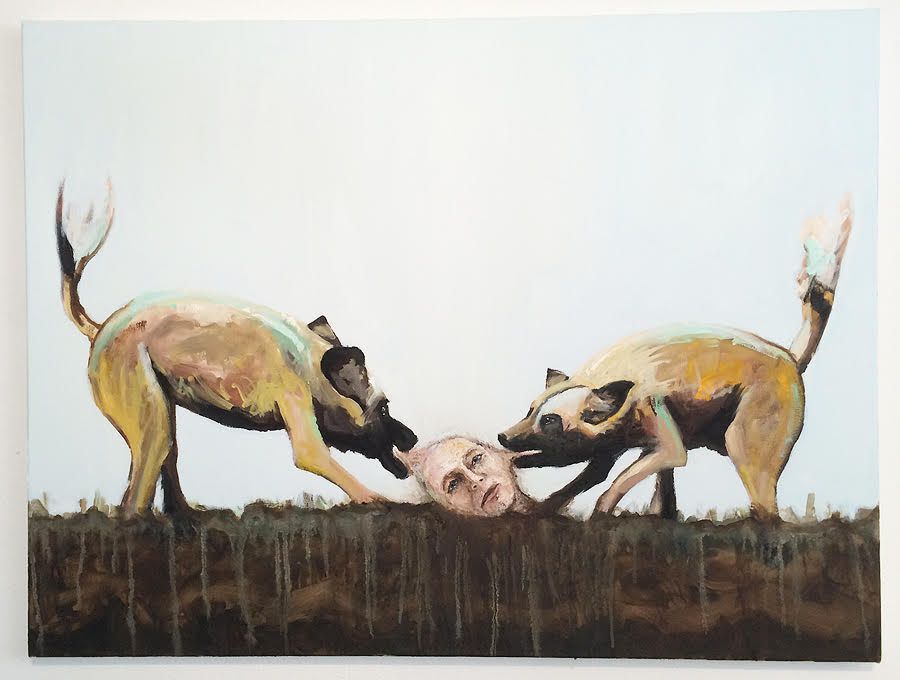Eve Wood on Julie Adler
1:1 invites writers to reflect on a single work of art with focus, care, and imagination to expand how we view, receive, and write about art.
By Eve WoodFebruary 6, 2024

1:1 invites writers to reflect on a single work of art with focus, care, and imagination to expand how we view, receive, and write about art. 1:1 is organized and edited by Annie Buckley.
The trouble began when I adopted two orphaned hyenas that I called Flo and Jasmina, though in truth I could never tell them apart. They seemed always to be hungry—not your run-of-the-mill hunger, like snacking on an unsuspecting grasshopper, but a voraciousness that suggested something more sinister. Oddly, they appeared to have no interest in meat at all, nor did they evince any fascination for vegetable matter or the veritable smorgasbord of insects I offered up every Thursday. Beetles were most definitely not their thing, though I did try.
As days became months, the hyenas were increasingly hungrier and ever more desperate, even as their bodies remained robust—leaping into the air to catch a butterfly or running full tilt after the mailman. They truly were the weirdest hyenas I’d met—not that I knew many, but still, what kind of hyena turns down frozen wildebeest entrails?
They appeared to subsist on air, or perhaps my good intentions. I pampered them terribly, dressing them in bright pink tutus and all manner of decorative flowers. They didn’t seem to mind, though occasionally one would announce their disapproval with a low, guttural growl. I decided they must be “secret eaters,” stealing scraps of food from the fridge late at night when no one was watching, but that didn’t hold water since there was never so much as a wayward scrap left behind. Perhaps their hunger was metaphorical, a hunger of the soul. This made some strange sense given that hyenas are one of the most misunderstood and maligned creatures in the world. I think it’s their laugh that’s so unnerving—a kind of jittery, panicky, whooping vocalization, as though they’d drunk 500 cups of coffee. Their appearance was also discomforting with their low rider demeanor and wiry, spotted fur, but I loved them.
I kept trying to get inside their heads to really understand them, and commissioned an artist friend to make a drawing of the three of us to commemorate what I thought was an unbreakable bond, only to be presented with a fierce and stunning rendition of my head as a chew toy! It was a disturbing yet strangely satisfying image, and the longer I gazed upon it, the more I realized that one day soon I would have to set them free.
One day, while staring at the painting, it occurred to me that their hunger could have emanated from my mind and that they were not in fact “real” but a reflection of my own endlessly grasping “self.” Perhaps I made the whole thing up and their hunger did not belong to them, but to me—a hunger to be seen and recognized, a hunger for connection and solidarity, a hunger to make sense of the world and my place within it, a hunger for the mind’s cessation—to stop asking for answers but to live and thrive within the full weight and scope of abandonment. Yes, that’s it, though I never could explain the clumps of spotted fur left behind on the couch.
¤
Featured image: Day Job, oil on canvas, 48 x 36 inches, ©2015 Julie Adler.
LARB Contributor
Eve Wood is an artist and poet who has been widely published, including in Best American Poetry, The New Republic, and The Atlantic Monthly.
Did you know LARB is a reader-supported nonprofit?
LARB publishes daily without a paywall as part of our mission to make rigorous, incisive, and engaging writing on every aspect of literature, culture, and the arts freely accessible to the public. Help us continue this work with your tax-deductible donation today!